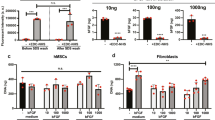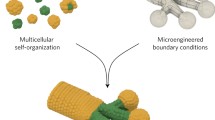Abstract
Work described herein characterizes tissues formed using scaffold-free, non-adherent systems and investigates their utility in modular approaches to tissue engineering. Immunofluorescence analysis revealed that all tissues formed using scaffold-free, non-adherent systems organize tissue cortical cytoskeletons that appear to be under tension. Tension in these tissues was also evident when modules (spheroids) were used to generate larger tissues. Real-time analysis of spheroid fusion in unconstrained systems illustrated modular motion that is compatible with alterations in tensions, due to the process of disassembly/reassembly of the cortical cytoskeletons required for module fusion. Additionally, tissues generated from modules placed within constrained linear molds, which restrict modular motion, deformed upon release from molds. That tissue deformation is due in full or in part to imbalanced cortical actin cytoskeleton tensions resulting from the constraints imposed by mold systems is suggested from our finding that treatment of forming tissues with Y-27632, a selective inhibitor of ROCK phosphorylation, reduced tissue deformation. Our studies suggest that the deformation of scaffold-free tissues due to tensions mediated via the tissue cortical cytoskeleton represents a major and underappreciated challenge to modular tissue engineering.











Similar content being viewed by others
References
Amack, J. D., and M. L. Manning. Knowing the boundaries: extending the differential adhesion hypothesis in embryonic cell sorting. Science 338(6104):212–215, 2012.
Dean, D. M., and J. R. Morgan. Cytoskeletal-mediated tension modulates the directed self-assembly of microtissues. Tissue Eng. Part A 14(12):1989–1997, 2008.
Dean, D. M., A. P. Napolitano, J. Youssef, and J. R. Morgan. Rods, tori, and honeycombs: the directed self-assembly of microtissues with prescribed microscale geometries. FASEB J. 21(14):4005–4012, 2007.
Fleming, P. A., W. S. Argraves, C. Gentile, A. Neagu, G. Forgacs, and C. J. Drake. Fusion of uniluminal vascular spheroids: a model for assembly of blood vessels. Dev. Dyn. 239(2):398–406, 2010.
Foty, R. A., C. M. Pfleger, G. Forgacs, and M. S. Steinberg. Surface tensions of embryonic tissues predict their mutual envelopment behavior. Development 122(5):1611–1620, 1996.
Foty, R. A., and M. S. Steinberg. The differential adhesion hypothesis: a direct evaluation. Dev. Biol. 278(1):255–263, 2005.
Fung, Y. C. What are the residual stresses doing in our blood vessels? Ann. Biomed. Eng. 19(3):237–249, 1991.
Gentile, C., P. A. Fleming, V. Mironov, K. M. Argraves, W. S. Argraves, and C. J. Drake. VEGF-mediated fusion in the generation of uniluminal vascular spheroids. Dev. Dyn. 237(10):2918–2925, 2008.
Han, H. C., S. Marita, and D. N. Ku. Changes of opening angle in hypertensive and hypotensive arteries in 3-day organ culture. J. Biomech. 39(13):2410–2418, 2006.
Heidemann, S. R., S. Kaech, R. E. Buxbaum, and A. Matus. Direct observations of the mechanical behaviors of the cytoskeleton in living fibroblasts. J. Cell Biol. 145(1):109–122, 1999.
Holtfreter, J. Gewebeaffinitat, ein mittel der embryonal formbildung. Arch. Exptl. Zellforsch. Gewebezucht 23:169–209, 1939.
Ingber, D. E. Tensegrity: the architectural basis of cellular mechanotransduction. Annu. Rev. Physiol. 59:575–599, 1997.
Ingber, D. E. Integrins, tensegrity, and mechanotransduction. Gravit. Space Biol. Bull. 10(2):49–55, 1997.
Katoh, K., Y. Kano, M. Amano, K. Kaibuchi, and K. Fujiwara. Stress fiber organization regulated by MLCK and rho-kinase in cultured human fibroblasts. Am. J. Physiol. Cell Physiol. 280(6):C1669–C1679, 2001.
Katoh, K., Y. Kano, M. Amano, H. Onishi, K. Kaibuchi, and K. Fujiwara. Rho-kinase-mediated contraction of isolated stress fibers. J. Cell Biol. 153(3):569–584, 2001.
Kelm, J. M., V. Lorber, J. G. Snedeker, D. Schmidt, A. Broggini-Tenzer, M. Weisstanner, et al. A novel concept for scaffold-free vessel tissue engineering: self-assembly of microtissue building blocks. J. Biotechnol. 148(1):46–55, 2010.
Korff, T., and H. G. Augustin. Integration of endothelial cells in multicellular spheroids prevents apoptosis and induces differentiation. J. Cell Biol. 143(5):1341–1352, 1998.
Korff, T., S. Kimmina, G. Martiny-Baron, and H. G. Augustin. Blood vessel maturation in a 3-dimensional spheroidal coculture model: direct contact with smooth muscle cells regulates endothelial cell quiescence and abrogates VEGF responsiveness. FASEB J. 15(2):447–457, 2001.
Lei, S., Y. P. Tian, W. D. Xiao, S. Li, X. C. Rao, J. L. Zhang, et al. ROCK is involved in vimentin phosphorylation and rearrangement induced by dengue virus. Cell Biochem. Biophys. 67(3):1333–1342, 2013.
Liu, S. Q., and Y. C. Fung. Zero-stress states of arteries. J. Biomech. Eng. 110(1):82–84, 1988.
Lyle, K. S., J. A. Corleto, and T. Wittmann. Microtubule dynamics regulation contributes to endothelial morphogenesis. Bioarchitecture 2(6):220–227, 2012.
Manning, M. L., R. A. Foty, M. S. Steinberg, and E. M. Schoetz. Coaction of intercellular adhesion and cortical tension specifies tissue surface tension. Proc. Natl Acad. Sci. USA. 107(28):12517–12522, 2010.
Mironov, V., V. Kasyanov, C. Drake, and R. R. Markwald. Organ printing: promises and challenges. Regen. Med. 3(1):93–103, 2008.
Moscana, A., and H. Moscana. The dissociation and aggregation of cells from organ rudiments of the early chick embryo. J. Anat. 86(3):287–301, 1952.
Nicol, A., and D. R. Garrod. The sorting out of embryonic cells in monolayer, the differential adhesion hypothesis and the non-specificity of cell adhesion. J. Cell Sci. 38:249–266, 1979.
Omelchenko, T., E. Fetisova, O. Ivanova, E. M. Bonder, H. Feder, J. M. Vasiliev, et al. Contact interactions between epitheliocytes and fibroblasts: formation of heterotypic cadherin-containing adhesion sites is accompanied by local cytoskeletal reorganization. Proc. Natl Acad. Sci. USA. 98(15):8632–8637, 2001.
Parsons, J. T., A. R. Horwitz, and M. A. Schwartz. Cell adhesion: integrating cytoskeletal dynamics and cellular tension. Nat. Rev. Mol. Cell Biol. 11(9):633–643, 2010.
Phillips, H. M., and M. S. Steinberg. Embryonic tissues as elasticoviscous liquids. I. rapid and slow shape changes in centrifuged cell aggregates. J. Cell Sci. 30:1–20, 1978.
Pollard, T. D., and J. A. Cooper. Actin, a central player in cell shape and movement. Science 326(5957):1208–1212, 2009.
Rachev, A., and S. E. Greenwald. Residual strains in conduit arteries. J. Biomech. 36(5):661–670, 2003.
Shutova, M., C. Yang, J. M. Vasiliev, and T. Svitkina. Functions of nonmuscle myosin II in assembly of the cellular contractile system. PLoS One 7(7):e40814, 2012.
Sokabe, M., K. Naruse, S. Sai, T. Yamada, K. Kawakami, M. Inoue, et al. Mechanotransduction and intracellular signaling mechanisms of stretch-induced remodeling in endothelial cells. Heart Vessels Suppl 12:191–193, 1997.
Stamenovic, D. Rheological behavior of mammalian cells. Cell Mol. Life Sci. 65(22):3592–3605, 2008.
Steinberg, M. S. Differential adhesion in morphogenesis: a modern view. Curr. Opin. Genet. Dev. 17(4):281–286, 2007.
Steinberg, M. S., and M. Takeichi. Experimental specification of cell sorting, tissue spreading, and specific spatial patterning by quantitative differences in cadherin expression. Proc. Natl Acad. Sci. USA. 91(1):206–209, 1994.
Stirbat, T. V., A. Mgharbel, S. Bodennec, K. Ferri, H. C. Mertani, J. P. Rieu, et al. Fine tuning of tissues’ viscosity and surface tension through contractility suggests a new role for alpha-catenin. PLoS One 8(2):e52554, 2013.
Wang, N., J. P. Butler, and D. E. Ingber. Mechanotransduction across the cell surface and through the cytoskeleton. Science 260(5111):1124–1127, 1993.
Wang, N., K. Naruse, D. Stamenovic, J. J. Fredberg, S. M. Mijailovich, I. M. Tolic-Norrelykke, et al. Mechanical behavior in living cells consistent with the tensegrity model. Proc. Natl Acad. Sci. USA. 98(14):7765–7770, 2001.
Youssef, J., A. K. Nurse, L. B. Freund, and J. R. Morgan. Quantification of the forces driving self-assembly of three-dimensional microtissues. Proc. Natl Acad. Sci. USA. 108(17):6993–6998, 2011.
Acknowledgments
The authors thank Dr. Susan M. Lessner, Ph.D. for her critical reading of this manuscript. This work was supported by NIH R01 DE019355 (MJY), NIH R01 HL080168 (CJD), NSF EPSCoR RII EPS-0903795 (CJD), and by NIH predoctoral fellowship T32 HL007260 (supporting CAC, awarded to Dr. Donald R. Menick, MUSC, PI). This study used the services of the Morphology, Imaging and Instrumentation Core, which is supported by NIH-NIGMS P30 GM103342 to the South Carolina COBRE for Developmentally Based Cardiovascular Diseases.
Author information
Authors and Affiliations
Corresponding author
Additional information
Associate Editor Scott I. Simon oversaw the review of this article.
Electronic supplementary material
Below is the link to the electronic supplementary material.
Supplementary Fig. 1. Diagram depicting toroid loading onto Bose ElectroForce 3100 uniaxial testing apparatus and initial dimensions of toroid. A1: Toroid is removed from agarose mold using forceps and placed around two horizontal cantilevers; A2-3: top cantilever is translocated 1.5 mm vertically to establish initial state, in which toroidal internal diameter matches that of the agarose mold central post (2.5 mm). Initial force mounted toroid exerts on cantilevers (avg: 0.09 ± 0.017 g) is set to zero at this time. B: Enlarged front-view of mounted toroid. Initial toroid length Lo was set as 2.5 mm, corresponding to the internal diameter at initial state. Cross-sectional area was obtained from measuring the cross-sectional diameters of intact, paraformaldehyde-fixed toroids and by imaging the fixed cross-sections and measuring cross-sectional diameters on the images. The average value 0.566 mm2 (n = 7) was used for all calculations. C: Example of stress–strain plot denoting locations from which values for ultimate tensile strength, Young’s modulus, and displacement at failure calculations were obtained.
Supplementary Fig. 2. Stress–strain plots obtained from load–displacement data acquired during uniaxial tensile testing of day 3 toroids. Day 3 Y-27632-treated toroids (bottom plot) showed elongated toe and linear elastic regions as compared to day-matched control samples (top plot).
Supplementary Table 1. Summary of results of Student’s t-test analysis of toroid ring opening experiments corresponding to Fig. 6 (p < 0.05). Confidence Intervals are expressed as absolute values (±). Based on F test, assumption of equal variance among samples was valid for all except T2. Significance level p < 0.05.
Supplementary Table 2. Summary of data used to calculate two-way ANOVA corresponding to biomechanical characterization of toroids in Figs. 8 and 9. As listed from top to bottom, each cell contains mean, variance, standard deviation, and standard error. Units for mean Young’s modulus and ultimate tensile strength are kPa; mean displacement at failure is reported in mm.
Supplementary Table 3. Summary of results of two-way ANOVA (two factors, two levels each: Y-27632 treatment vs. control and 3 vs. 6 days in culture) corresponding to biomechanical characterization of toroids in Figs. 8 and 9. SS—sum of squares; df—degrees of freedom; MS—mean square. Significance level p < 0.05.
Supplementary Table 4. Summary of results of post-test calculations with Bonferroni correction corresponding to biomechanical characterization of toroids in Figs. 8 and 9. ‘3’ or ‘6’ indicates culture duration (i.e., day 3 or day 6, respectively); ‘C’ or ‘I’ indicates treatment (i.e., control or Y-27632-treated, respectively). Significance level p < 0.05.
Rights and permissions
About this article
Cite this article
Czajka, C.A., Mehesz, A.N., Trusk, T.C. et al. Scaffold-Free Tissue Engineering: Organization of the Tissue Cytoskeleton and Its Effects on Tissue Shape. Ann Biomed Eng 42, 1049–1061 (2014). https://doi.org/10.1007/s10439-014-0986-8
Received:
Accepted:
Published:
Issue Date:
DOI: https://doi.org/10.1007/s10439-014-0986-8




